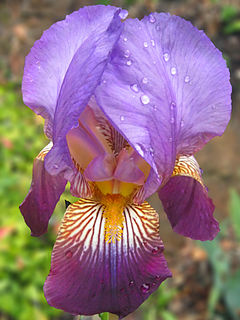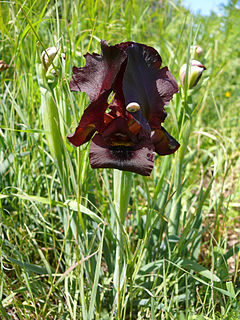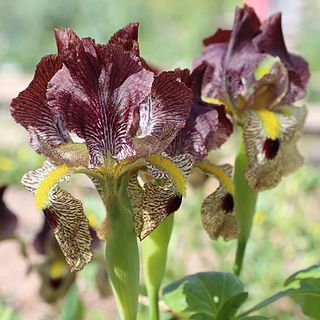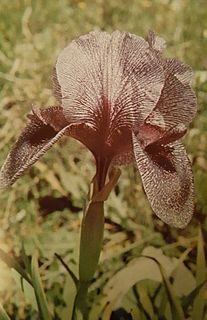
Subgenus Iris is one subgenus of Iris.

Iris hoogiana is a plant species in the genus Iris, it is also in the subgenus Iris and in the section Regelia. It is a rhizomatous perennial, from the grassy mountainsides of Turkestan. It has long green leaves, which are slightly purple at the base, and a long slender flowering stem. The flowers are blue, ranging from sky-blue to lavender blue and blue purple. It has orange or yellow beards. It is cultivated as an ornamental plant in temperate regions.

Iris acutiloba subsp. lineolata is a species in the genus Iris, it is also in the subgenus of Iris. It is a subspecies of Iris acutiloba, and is a rhizomatous perennial, from the mountains of Iran, Turkey, Turkmenistan, Tajikistan and Azerbaijan. It has narrow, lanceolate, or falcate (sickle-shaped) leaves, which are grey-green and glaucous. It has a slender straight stem holding one terminal flower. The flowers, come in shades of white, cream, or creamy white and have veining that is purple or brown, or a mixture of both. It is heavily veined or streaked in purple or brown, with a dark purple-brown, spot on 3 of the outer petals and brown, dark purple, or black short beard. It is rarely cultivated as an ornamental plant in temperate regions, unless grown in a greenhouse.

Iris acutiloba is a species in the genus Iris, it is also in the subgenus of Iris and section Oncocyclus. It is a rhizomatous perennial, from the mountains of the Caucasus and found in Turkey, Armenia, Azerbaijan, Turkmenistan, Dagestan in the North Caucasus, and Iran. It is a dwarf species, with narrow, falcate or curved leaves, it has one flower in spring or early summer, that comes in shades from cream, creamy white, whitish, pale brown, light grey, to pale violet. It is heavily veined or streaked and pointed, with 2 dark spots and brown, purple, dark purple, or black short beard. It is cultivated as an ornamental plant in temperate regions. There are two subspecies, Iris acutiloba subsp. lineolata and Iris acutiloba subsp. longitepala.
Iris antilibanotica is a species in the genus Iris, it is also in the subgenus Iris. It is a rhizomatous perennial, from the mountains of Syria. It has semi-evergreen, green, falcate leaves, slender stem, bi-coloured flowers, in dark purple, violet. With a small dark spot and purple tipped yellow beard on the outer petals. It is rarely cultivated as an ornamental plant in temperate regions and thought to be extinct in the wild.

Iris atrofusca is a species in the genus Iris, where it is placed in the subgenus Iris and the section Oncocyclus. It is a rhizomatous perennial from the deserts of Israel and Jordan. The species has long falcate (sickle-shaped) or ensiform (sword-shaped) leaves, a long thick stem and large fragrant flowers that come in shades of purple brown, reddish-black, black-brown, dark brown, dark lilac or dark purple. The flowers also have a black or brownish-black signal patch and a thick beard that is brown-black, light brown or yellow tipped with brown. It is rarely cultivated as an ornamental plant in temperate regions.

Iris atropurpurea, the coastal iris is a species in the genus Iris, it is also in the subgenus of Iris and in the section Oncocyclus. It is a rhizomatous perennial, from the Middle East. It has glaucous (blue-green), linear, falcate (sickle-shaped) leaves. Between February and March, it has between 1 and 2 flowers, in dark shades from red-brown, burgundy, dark purple to blackish purple. They have a darker signal patch and yellow beard tipped with purple. It is rarely cultivated as an ornamental plant in temperate regions, due to it needing very dry conditions.

Iris barnumiae is a species in the genus Iris; it is also in the subgenus Iris and in the section Oncocyclus. It is a rhizomatous perennial, from Armenia, Azerbaijan, Iran, Iraq, and Turkey. It has pale glaucous green and narrow leaves, that are slightly sickle-shaped and fade soon after blooming. It has, in mid- to late spring, fragrant flowers in shades of purple, from red-purple, mulberry to purplish-violet, with a yellow tipped with purple beard. It was renamed as I. barnumiae in after a plant naming conference in 2011, but is still sometimes named as I. barnumae in some sources. It has one accepted subspecies Iris barnumiae subsp. demawendica and two forms; Iris barnumiae f. protonyma (Stapf) B.Mathew & Wendelbo and Iris barnumiae f. urmiensis (Hoog) B.Mathew & Wendelbo, which has yellow flowers. Sometimes I. barnumiae f. barnumiae is used to describe the basic form. It is rarely cultivated as an ornamental plant in temperate regions, due to its needing very dry and warm summer conditions.

Iris bismarckiana, the Nazareth iris, is a species in the genus Iris, it is also in the subgenus Iris and in the section Oncocyclus. It is a rhizomatous perennial, from the mountainsides of Israel, Lebanon, Jordan and Syria. It has stoloniferous, spreading rhizomes, long, sword shaped, bright green leaves, long slender stem and 1 flower in Spring. The large flower is pale yellow, creamy-white, or white background. Which is covered with reddish-brown, maroon brown, purple-brown, purple, blue-purple, or blue veins, markings or spots. It has a dark signal patch and dark purple to black beard. It is rarely cultivated as an ornamental plant in temperate regions, as it needs very dry conditions during the summer.
Iris camillae is a species in the genus Iris, it is also in the subgenus Iris and in the section Oncocyclus. It is a rhizomatous perennial, from Azerbaijan. It has narrow, falcate (sickle-shaped) leaves, medium-sized stem and large flowers, where the flower colour is very variable, ranging from violet, purple, pale blue, and also yellow, and occasionally bi-colour forms are found. It has a yellow beard. It is rarely cultivated as an ornamental plant in temperate regions, due to its environmental conditions of its natural habitat.
Iris cedreti is a species of flowering plant in the genus Iris; it is also in the subgenus of Iris. It is a rhizomatous perennial endemic to Lebanon. It has long narrow leaves, short stem, and flowers with a white background which is covered with very small dots or veins of dark maroon, purple, purplish-maroon, or almost black. It has a dark maroon signal patch with a brownish or purplish beard. It is rarely cultivated as an ornamental plant in temperate regions, as it needs very dry conditions during the summer. It is listed as critically endangered by the IUCN.

Iris hermona, the Golan iris, is a plant species in the genus Iris, it is also in the subgenus of Iris, and in the section Oncocyclus. It is a rhizomatous perennial, from the pastures and meadows of the Golan Heights in Israel and Syria. It has linear, upright leaves, tall slender stem holding a bi-coloured flower, having a pale lilac, cream-yellow, light tan, or white background, which is then covered in purple brown, or purple, or purple-pink veining, spots or speckling. It has a round purple-brown or almost black signal patch, and a sparse purple brown or almost black beard. It is rarely cultivated as an ornamental plant in temperate regions, as it needs very dry conditions during the summer.
Iris heylandiana is a species in the genus Iris, it is also in the subgenus Iris, and in the section Oncocyclus. It is a rhizomatous perennial, from the marshlands or fields of Iraq. It has short, linear or sickle shaped grey-green leaves, slender stem, a single flower in spring, which has a dingy-white, whitish, or pale background, which is covered in many spots or dark veining, in black-purple, brown-purple, or brown violet, or brown shades. It has a dark brown or burgundy brown signal patch and white tinged with yellow or orange white sparse beard. It is rarely cultivated as an ornamental plant in temperate regions, as it needs very dry conditions during the summer.

Iris iberica subsp. elegantissima is a subspecies in the genus Iris, subgenus Iris and section Oncocyclus. It is a subspecies of Iris iberica and is a rhizomatous perennial, from Armenia, Turkey and Iran. It has large, thin and falcate (sickle-shaped) leaves, slender stem with a single flower between April and May. It has a white, cream or pale yellow ground, which is covered in dark veining or speckling in violet, mauve, purple or brown shades. The larger standards are paler, normally white and less veined. The falls, have darker veining and a dark signal patch and brown or purple beard. It is commonly known as Iris elegantissima, especially in Europe and Russia. It is cultivated as an ornamental plant in temperate regions, but normally needs some protection during the winter period.

Iris paradoxa is a species of flowering plant native to western Asia. It has large upright petals and smaller lower petals, which is unique amongst most iris forms. They come in various shades from white, lavender, mauve, medium purple, violet, dark purple to black. It has a black or purplish black beard on the lower petals. It comes from the region of Transcaucasia, and is found in the countries of Iran,, Turkey, Armenia and in Azerbaijan.

Iris susiana, commonly known as the mourning iris, is a species of perennial plant in the family Iridaceae. The mourning iris is native to the Middle East. It grows in Lebanon, Syria and Turkey, although it is believed to be extinct in the wild. It is popular as a cut flower as the flowers can easily span 12 centimeters. The survival of the species is seriously threatened by excessive picking.

Iris sari is a species in the genus Iris, it is also in the subgenus of Iris and in the Oncocyclus section. It is from the rocky steppes and hills of Turkey. It has curved or straight leaves, cream, greenish or yellowish flowers which are variable and veined with crimson, purple-brown, reddish brown, reddish-purple or black. It has a dark maroon, rich crimson or brown signal patch and gold or yellow beard.

Iris sprengeri is a species in the genus Iris, it is also in the subgenus of Iris and in the Oncocyclus section. It is from the mountain slopes of Turkey. It has large flowers which are white, silver-white or cream, with purple-red or reddish-brown veining and a golden yellow beard and a dark purple or deep purple-brown signal patch.
Iris kirkwoodiae is a plant species in the genus Iris, it is also in the subgenus Iris and in the section Oncocyclus. It is a rhizomatous perennial, from Syria and Turkey. It has white or pale greenish flowers, heavily covered with dark purple veins or dots, deep purple round signal and a beard of long brown/purple hairs. It is cultivated as an ornamental plant in temperate regions.
Iris westii is a species in the genus Iris, it is also in the subgenus of Iris and in the Oncocyclus section. It is from the mountain sides of Lebanon. It has curved grey-green leaves, a stem carrying one flower in shades of lilac, white or beige with spotting or veins in a darker shade or violet. The lower petals have deep velvety chocolate or deep violet-black signal patch and a purple beard. It rare and threatened due to habitat destruction, from military actions, overgrazing by goats and other factors.














